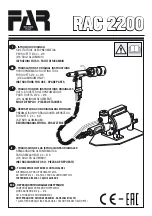
37
Need help or have any questions? Call us at 1-714-963-0329 or send us an e-mail at [email protected]
☞
Lateral balancing will make the airplane easier to trim and will make it track straighter in the air. It is strongly
recommended.
❑
With the airplane right-side up, tie one length of string to the propeller shaft and loop another piece of string around the
fuselage right in front of the horizontal stabilizer.
❑
With someone helping you, carefully lift the airplane up by the two pieces of string. Watch how the wing reacts. If one
side of the wing drops, that side is heavier than the other. To correct this condition, stick a small piece of self-adhesive lead
weight to the bottom of the lighter wing half (the one that doesn't drop). For best mechanical advantage, place the weight
as close to the wing tip as possible.
❑
Repeat the procedure a couple of more times to double-check your findings. When done properly the wing should stay
level when you lift the airplane.
SECTION 21: LATERAL BALANCING THE KWIK FLY II ARF
SECTION 22: CONTROL THROWS
We recommend setting up the Kwik Fly II using the control throws listed below. These control throws are suggested
for initial test-flying because they will allow the airplane to fly smoother and make it easier to control.
TEST-FLYING
Ailerons:
3/8" Up
3/8" Down
Elevator:
3/8" Up
3/8" Down
Rudder:
1" Right
1" Left
☞
When measuring the control throws, measure from the widest point of the control surfaces.
VERY IMPORTANT
After you are finished adjusting the pushrods and control throws, we strongly suggest cutting 1/4"
lengths of the clear tubing provided and sliding one piece over each clevis. The tubing will prevent the clevises from
popping open during flight.
Once you're familiar with the flight characteristics of the airplane, you might want to increase the control throws to the
Aerobatic Flying settings listed below. These control throws will make the airplane more responsive and allow you to do
aerobatics with ease.
AEROBATIC FLYING
Ailerons:
3/4" Up
3/4" Down
Elevator:
3/4" Up
3/4" Down
Rudder:
1-1/2" Right
1-1/2" Left
We do not suggest increasing the control throws beyond the recommended Aerobatic Flying settings unless you are a
very proficient flyer. Higher control throws will cause the airplane to be extremely control-sensitive and result in a
possible crash if you are not careful.
SETTING UP THE CENTER-FLAP
The center-flap should deflect down a maximum of 1/2". This can be set on either a rotary knob or on a 3-way switch.
☞
If the airplane balloons up after deploying the center-flap, you are at too high a flight speed. To minimize this, either
deploy the center flap at a lower flight speed or, if you have a programmable radio, use it to mix a couple of degrees of down
elevator when the center-flap is deployed.








































